Constipation in cats

You’ve watched your cat walk in and out of the litter box several times, which is unlike him.
When he was in the box, he was straining, and he even cried out a few times. But when you checked, he hadn’t pooped at all.
You suspect your cat is constipated. Is this something you should be worried about, or will constipation resolve itself, like it often does in humans?[1]
The short answer is that constipation in cats can become serious surprisingly quickly. The problem is that being constipated for too long (which isn’t very long at all), can cause permanent damage to a cat’s colon.
Keep reading to understand what happens to cats when they get constipated.
What is constipation in cats?

In a healthy cat, it takes about 20 hours (more or less) for food to move from her mouth to her litter box as poop.[2]
But if things don’t go smoothly, the poop can get stuck partway through the journey.
The intestines are supposed to be moving things along, keeping everything soft and moist and flexible. But sometimes, poop stops at the colon and never makes its way to the rectum and out through the anus, the way it’s supposed to.
It’s a problem that kind of feeds on itself: the more poop that accumulates in the colon, the harder and drier and more difficult it becomes for the cat to pass any of it.
Constipation in cats refers to a reduced frequency of pooping or the complete absence of poop.
What does normal cat poop look like?

If your cat is constipated, you’re probably going to notice that his poop, if he is able to produce one, looks different. So, it’s important to first know what a healthy cat’s poop looks like.
A healthy cat poop is rich brown in color. It’s about four to six inches in length, and shaped like a sausage.[3] (I’m sorry. That’s probably the last time you’re ever going to eat sausage.)
A normal cat poop has enough moisture so that litter sticks to it, but not enough moisture to really leave a mark on a hard surface, if that’s where you’re picking it up from.
A healthy poop should be firm and hold its shape, but not so firm that you can’t squeeze it. I’m assuming you’re wearing gloves if you’re squeezing cat poop.
How often should a cat poop?
The other thing you have to know, before coming to the conclusion that your cat might be constipated, is how often a healthy, non-constipated cat poops.
Most cats poop every 12-24 hours.[4]
If it’s been more than 48-72 hours without a poop, you need to contact your vet.[5]
What does a constipated cat look like?
Aside from an absence of poop in the litter box, or not enough poop in the litter box, there are telltale signs that a cat might be suffering from constipation:
- Your cat appears to be straining in the litter box.
- Your cat is holding herself in hunched position.
- She is frequently entering and exiting the litter box.
- She might be avoiding the litter box.
- She is hiding.
- Your cat may have difficulty jumping up.
- She might be walking stiffly.
- She might seem to be peeing more than normal.
- Poop in the litter box, if there is any, is hard, dry, and pebble-shaped.
- Your cat may appear to have abdominal pain.
- Your cat may pass small amounts of what looks like diarrhea.[6],[7]
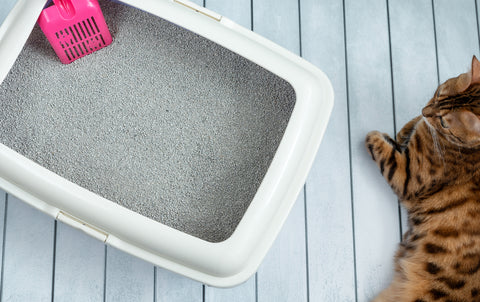
Note that this last bullet point does not refer to actual diarrhea. Cats who are constipated may pass a small amount of liquid feces or even blood, due to all that straining. The liquid is just able to scootch around the mound of hard, dry feces in the colon.
(Read all about cats and diarrhea in this post.)
A little liquid feces doesn’t mean that your cat’s constipation is resolved.
What causes constipation in cats?
There are many potential causes of constipation in cats:
Dehydration
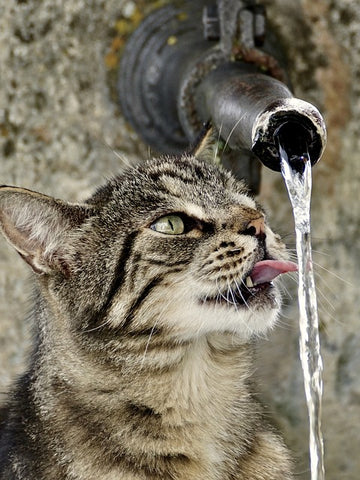
Cats are notoriously fussy about drinking water. Cat guardians need make sure that they’re doing everything possible to ensure that their cats are drinking enough to stay hydrated.
I’ve written a blog post about this topic (Why won’t my cat drink out of her bowl?), with tips for encouraging a cat to drink more.
Dehydration contributes to constipation because it’s the job of the colon to absorb moisture from poop if the rest of the cat’s body needs it.
So, if a cat isn’t drinking enough water, the colon will “save” the water in the poop and pass it back to the cat’s body cells, where it’s needed even more.
This turns moist poop that would otherwise glide effortlessly through the digestive tract, into hard and dry lump that gets stuck in the colon instead.[8]
Note that chronic kidney disease (CKD), which causes cats to pee more and thus, potentially, become dehydrated, can also cause constipation.[9]
Litter-box issues
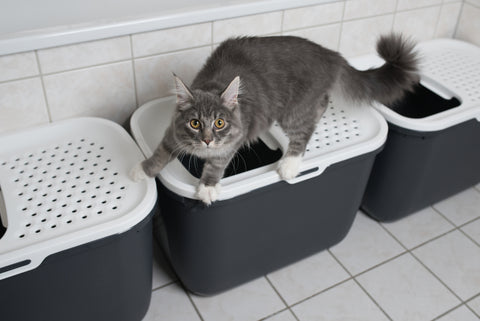
The fact that cats use a litter box is nothing short of a miracle. Even though we tend to take the litter box for granted, cats were not designed to pee and poop in a tiny box with fake sand in it. It’s your job, as cat guardian, to understand this miracle, and to treat it like the marvel that it is.
Your cat might not use the box if it’s not clean enough. He might not use the box if he feels like there’s too much competition for the litter box from his kitty housemates. He might not use the litter box if he doesn’t like the litter you picked out. He might not use the litter box if he doesn’t like the location of the litter box.
And if your cat is “holding it” because he just doesn’t like the litter-box situation in your house, you may end up with a constipated cat. And a constipated cat is a much bigger problem than just cleaning the litter box, moving the litter box, or putting out extra litter boxes.
Here is some reading on these topics:
Should you toilet train your cat?
How many litter boxes do I need?
How to keep litter box odor under control
Pain
Anything that causes pain, especially pain that might be triggered by attempting to poop, can cause a cat to avoid pooping, and thus become constipated.

Osteoarthritis can make getting in and out of the litter box too painful, for example. Alternatively, if your cat has eaten something she shouldn’t have, like a bone, it could damage the lining of the colon as it moves through, and discourage a cat from pooping.
Abscesses, or irritation of the skin around the anus, or impacted anal glands could also cause a cat to stop pooping to avoid pain.[10]
Obstructions
Anything that prevents poop from zooming along through the bowels can cause constipation.
If a cat has a pelvic injury that results in a narrowing of the pelvic canal, that could cause poop to back up.[11]
Tumors[12], foreign bodies, even really bad hairballs can become roadblocks that would prevent poop from exiting the body like it’s supposed to.
Disease
Some metabolic diseases, like hypothyroidism or diabetes, or diseases that affect blood levels of potassium or calcium,[13] can interfere with the colon’s ability to contract normally and move poop on through.
Constipation can also be a side effect of certain drugs used to treat disease, too.
What kind of cat tends to get constipated?
Any cat, at any age, can suffer from constipation.
But it’s mostly middle-aged cats who tend to suffer from it.[14]
What is megacolon in cats?

Megacolon is a condition that either causes constipation in cats, or is caused by constipation in cats. It’s a chicken-or-the-egg kind of problem.
Megacolon describes a flabby, weak colon that can’t squeeze hard enough to push poop out.
Sometimes megacolon is a “primary” condition, meaning that a cat already has megacolon, and megacolon is the problem causing the constipation. In other words, the colon is so baggy and loose that poop collects in it, and the muscles lining the colon aren’t strong enough to send that poop on its way.
Sometimes megacolon is a “secondary” condition, meaning that a cat gets constipated, and it’s the constipation that causes the megacolon. In other words, too much poop collects in the colon, and that volume of poop stretches out the colon and affects its ability to contract properly.[15]
When should you bring your cat to the vet for constipation?
If your cat hasn’t pooped in 48-72 hours, or, if your cat appears uncomfortable, you should bring him to the vet.
The idea is to treat the constipation before the colon becomes too stretched out.[16]
Your vet will help you:
- Identify the cause of the constipation.
- Correct the cause of the constipation.
- Remove the stuck poop.
- Prevent a reoccurrence of the constipation.
How are constipation and megacolon diagnosed by a veterinarian?
Vets attempting to diagnose constipation or megacolon in a cat are going to look for the same symptoms that you’re looking for (see above).
But they can also often feel the poop collecting in the colon, just from the outside of the cat’s body.[17]
But there are other tests your vet may conduct, too (see below).
What can my vet do to help my constipated cat?

If this is the first time your cat is constipated, your vet may suggest a simple, therapeutic procedure to rehydrate her with subcutaneous (under the skin) or intravenous (IV) fluids.[18]
Sometimes, the poop is so stuck that your cat will require an enema. A vet will inject water through the cat’s anus to her colon. This will add water to the dry poop and will also stimulate the colon to contract.
By the way, do not attempt to give your cat an enema at home. Enemas designed for humans can be very toxic to cats.[19]
Your vet may also manually remove the poop from your cat’s colon. Your cat will likely need to be sedated for this procedure.
What tests might my vet recommend for my constipated cat?
If there isn’t a clear, simple explanation for the constipation, or, if constipation is a chronic problem for your cat, your vet may want to explore the problem further.
X-rays
Your vet may suggest taking a few X-rays of your cat to look for pelvic injuries, tumors, or strictures (narrowing) of the exit from the colon, or anything that might be keeping the poop inside the cat.
X-rays can also show arthritis, or other orthopedic problems that might be making it difficult for your cat to get in or out of the litter box, or squat comfortably to poop.
Blood and urine tests
Blood tests can answer questions about whether your cat is suffering from a metabolic disease that might be causing chronic constipation.
Urine tests can tell your vet how dehydrated your cat really is.
Ultrasound
Ultrasound can also be useful in assessing a cat’s mobility, and can help guide a biopsy of any suspicious lesions in a cat’s digestive tract.
Neurological exam
If your vet suspects that a neurological problem – a dysfunction in the brain, spinal cord, or nerves – is behind your cat’s chronic constipation, he or she may recommend a full neurological exam.
Certain cat breeds, such as the Manx cat, are prone to disorders of the spinal cord.
What treatments are available for cats who are chronically constipated?

Your vet has an arsenal of medications to help a cat who is chronically constipated.
There are stool softeners that increase the amount of water the poop absorbs in the gut.
There are lubricating laxatives that work by increasing the water content in the poop and making the poop more slippery so that it’s easier to pass.
There are prescription high-fiber diets that add weight and bulk to the poop to make it easier to pass.
There are intestinal motility modifiers that increase the force of contractions in the colon.[20]
Is surgery ever necessary for constipation or megacolon?
Surgery is not typically necessary for most cats suffering from constipation.
In the unlikely event that there is a permanent loss of function of part of the colon (called obstipation), or severe megacolon, your vet may recommend surgery to save your cat’s life.[21]
This is a significant procedure and not one that most vets would undertake lightly. Usually, a cat would be suffering with megacolon for at least six months, and would not be responding to medical management of the problem before surgery would ever be considered.
How can you prevent your cat from becoming constipated?
(*Note: as an Amazon Associate, I may earn from qualifying purchases.)
Encourage your cat to drink more

Many cats become dehydrated because they are simply not drinking enough water. Read this post to understand why cats don’t tend to drink very much and what you can do about it, including:
- Changing the type of water bowl
- Moving the water bowl away from the food bowl
- Adding a kitty water fountain (like this one, by PetLIBRO)
- Leaving a dripping faucet for your cat.
If you feed your cat dry food, consider switching to wet food. You can read all about the differences between wet food and dry in this post.
You can also try this unusual product made by Purina, called Hydra Care, which can help a cat consume more liquid and absorb more water into their cells.
Keep your cat at a healthy weight
You can help prevent constipation in cats by making sure your cat is a healthy weight. Obesity in cats can cause inflammation in the intestines, which can really slow things down. In really overweight cats, extra fat can actually interfere with the movement of poop through the gut.[22]
Read this post about helping your cat lose weight.
Make sure your cat loves his litter box
Make your cat’s litter box as appealing as possible:
- Make sure your cat has enough litter boxes to choose from. The magic number is 1 + the number of cats in your home.
- Make sure you have a litter box on every floor of your house.
- Make sure your litter box is up to your cat’s personal standard of cleanliness.
- Make sure the litter boxes are in quiet, private locations, but not in a tight corner or at the end of a hallway, where your cat could feel trapped.
Give your cat a reason to move
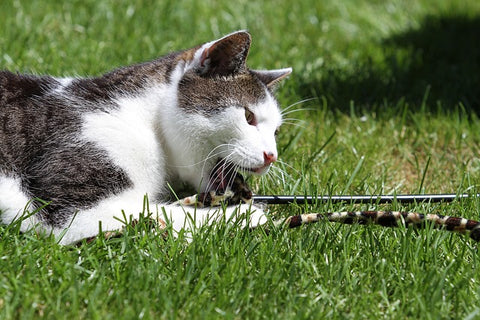
A sedentary life is not good for anyone, and it’s especially unhealthy for your cat’s gut.
Activity can promote normal, healthy movement of your cat’s intestines. Give your cat a variety of toys, trees, and window seats to encourage him to get up and move around.
But most importantly, play with your cat! There is nothing more interesting than you in your cat’s world. And no better prescription for good kitty health.
Love Pinterest? Here's a Pinterest-friendly pin for your boards!
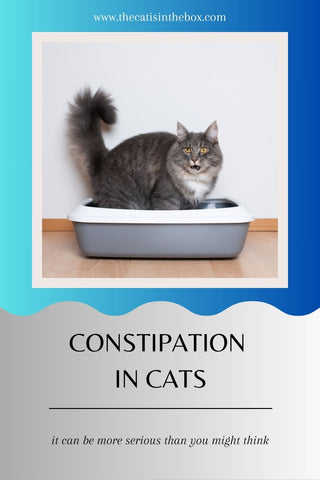
Dawn LaFontaine is a lifelong animal lover who always seems to have a little pet hair in her keyboard. Her blog, Kitty Contemplations, helps cat guardians better understand and care for the special beings they share their lives and homes with. Her cat-products business, Cat in the Box, sells beautiful, well-made, and award-winning products that she designed to meet the biological needs of cats.
_______________
FOOTNOTES
[1] Jenkins, Sarah. “How to Relieve Constipation.” National Association For Continence, 31 Jan. 2023, nafc.org/bhealth-blog/how-to-relieve-constipation/.
[2] “Animal Digestive Systems.” Gastrointestinal Society, 14 Feb. 2022, badgut.org/information-centre/a-z-digestive-topics/animal-digestive-systems/.
[3] Corbin, Dr. Jennifer. “How to Understand Your Cat’s Stool [Cat Poop Chart].” Dutch, Dutch, 21 Dec. 2021, www.dutch.com/blogs/cats/cat-poop-chart.
[4] “8 Ways to Help Your Constipated Cat.” PetMD, www.petmd.com/cat/general-health/cat-constipation-how-to-help. Accessed 13 Oct. 2023.
[5] ibid.
[6] Weir, Malcolm, and Ernest Ward. “Constipation in Cats: VCA Animal Hospital: VCA Animal Hospitals.” Vca, vcahospitals.com/know-your-pet/constipation-in-cats. Accessed 10 Oct. 2023.
[7] “AnimERge.” New Jersey Emergency Vet | Emergency Veterinary Services, www.animergevets.com/site/blog/2021/01/15/constipation-dogs-causes-symptoms-treatment. Accessed 13 Oct. 2023.
[8] “All Bunged up: Unclogging the Constipated Cat.” DVM 360, www.dvm360.com/view/all-bunged-unclogging-constipated-cat. Accessed 13 Oct. 2023.
[9] “8 Ways to Help Your Constipated Cat.” PetMD.
[10] “AnimERge.” New Jersey Emergency Vet | Emergency Veterinary Services.
[11] Betancourt, Dr. Fernando. “6 Ways to Help Your Constipated Cat.” Veterinary Emergency Group, 1 May 2023, veterinaryemergencygroup.com/blog/6-ways-to-help-your-constipated-cat/.
[12] “8 Ways to Help Your Constipated Cat.” PetMD.
[13] Betancourt, Dr. Fernando. “6 Ways to Help Your Constipated Cat.”.
[14] Weir, Malcolm, and Ernest Ward. “Constipation in Cats: VCA Animal Hospital: VCA Animal Hospitals.”
[15] ibid.
[16] “8 Ways to Help Your Constipated Cat.” PetMD.
[17] Weir, Malcolm, and Ernest Ward. “Constipation in Cats: VCA Animal Hospital: VCA Animal Hospitals.”.
[18] “All Bunged up: Unclogging the Constipated Cat.” DVM 360.
[19] “8 Ways to Help Your Constipated Cat.” PetMD.
[20] “Constipation.” Cornell University College of Veterinary Medicine, 17 June 2021, www.vet.cornell.edu/departments-centers-and-institutes/cornell-feline-health-center/health-information/feline-health-topics/constipation.
[21] ibid.
[22] “8 Ways to Help Your Constipated Cat.” PetMD.
This post provides more info on how to help cats stay hydrated.

